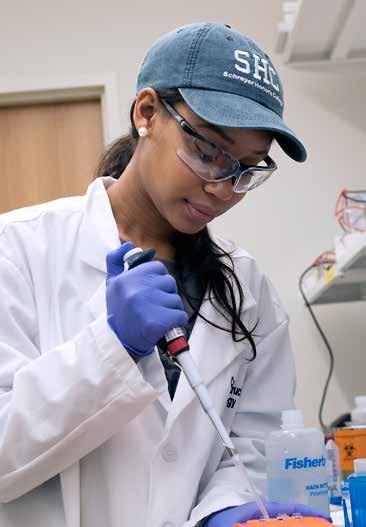
9 minute read
Assessment leads to defined student outcomes
In Focus Assessment delivers learning outcomes that will better define honors experience
The mission of the Schreyer Honors College gives its students worthy goals to aspire to. After a comprehensive two-year assessment, the College is now in a better position to determine if its Scholars are reaching those goals.
Advertisement
Working with College administrators and members of the Faculty Advisory Committee and gathering input from staff and students, College of Education associate professors David Guthrie and Karen Paulson collected data, conducted surveys, studied other honors programs, and ultimately helped the College create four distinct student learning outcomes.
Students who graduate from the Honors College will: 1.) Develop, engage in, and communicate scholarship in their field in order to examine and critically analyze selected topics, issues, or problems;
2.) Embody ethical principles in personal, academic, professional, and societal contexts;
3.) Demonstrate respect for human differences, understanding of global inter- dependency, and engagement in civic life; and,
4.) Collaborate with others and demon- strate leadership by exploring opportu- nities or implementing initiatives.
The assessment team also created suggestions to document achievement of those learning outcomes, such as Scholars tailoring class papers or even their thesis to topics linked to those outcomes or providing evidence of the impact of their study abroad experiences.
Beginning in the summer of 2018, Guthrie and Paulson conducted interviews with more than a dozen staff members to gain a better understanding of the day-to-day workings of the College and big- picture goals. They surveyed various student subpopulations to get an idea of their understanding of their honors experience. They also formed four subcommittees, which included members of the Faculty Advisory Committee and the Rock Ethics Institute, assigning one outcome to and leading multiple meetings for each.
Parts of the mission, including academic excellence and integrity, were already relatively easy to measure and thus fold into the outcomes. Other parts, such as global perspective and civic engagement, were more difficult. The assessment led to the creation of initiatives that should make those aspects more quantifiable.
A newly designed and required ENGL202 honors course, in addition to helping students with thesis prep, will include ethics discussions as part of the curriculum, and a redesigned honors experience tracker in the Student Records System will allow Scholars to track and identify how their extracurricular activities align with the learning outcomes.
The assessment will also help staff ensure that student programming and services have direct connections to meeting the outcomes.
“It has made us more mindful about aligning our policies and trying to make them more coherent,” said Schreyer Honors College Associate Dean Keefe Manning. “The assessment has been a little bit more eye-opening for staff that there’s a more structured way to do this and help us improve the student experience.”
By more clearly defining outcomes, the College also will help ensure that students who enter during their sophomore or junior years will be held to the same standards as the first-year entrants. “The data that we’ve collected from the survey would suggest that a second- or third-year entry student has a different experience than a student who entered as a first-year student,” Guthrie said.
To that end, the College will hold workshops for entering students to selfevaluate their moral and ethical baselines. When they are about to graduate, they will be asked the same questions in exit workshops.
“For the first-year student, the change could be significant,” Manning said. “For the third-year student, their change may not have been as impactful, but they’ll have gone through the same ex- periences as other students in terms of how they’re thinking about themselves.”
Paulson believes the assessment will help honors advisers and faculty have a better understanding of what is expected from them in those roles and also give prospective students a clearer sense of what the College can provide.
“What do they get from being an honors student?” Paulson said. “The Honors College wants to know ‘Did it make a difference to this student?’ It will also help identify which students actually want to come, which want to do more than just do their homework and get straight As. It’s so much more than that.”
Schreyer Honors College Dean Peggy A. Johnson says the outcomes will help students and staff better measure the impact of things like community service — on both the students and the communities — and better define terms like “global perspective.” She also believes it will help Scholars feel more connected to the mission regardless of their level of interaction with the College. “My hope is that it doesn’t have much of an impact on the students’ burden,” Johnson said. “I don’t want them to be loaded down with stuff that isn’t working toward them getting a degree. I would love for them to be aware that what they’re learning ties directly to our mission.”
The assessment plan used existing data but also helped the College identify which data it will prioritize moving forward. It now has an existing framework to use for future assessments, which can be adjusted to changing technology or changing administrators but will provide an important starting point.
“We have now reached a point where we can articulate ‘This is what we want our students to do and think and create,’ but this is an ongoing process,” Manning said. “It’s a process that in any organization, you do yourself a disservice if you’re not constantly evaluating yourself.”
THE SCHOLA RS MEDAL
The medal, which Scholars receive in recognition of their achievements, and which they will wear at commencement, was designed by John A. Cook, professor emeritus of art in the College of Arts and Architecture. He describes his design for the medal in this way:
“While the lion is certainly no stranger to Penn State, this particular species with flowing mane has not been much in evidence since 1942 when Heinze Warneke’s version established residence as the athletic logo.”
“A suitable symbol for the Schreyer Honors College requires something agile and alert with the potential to reach out and encompass new dimensions of thought.”
“The lion thus depicted emerges with extended claws to become the University’s symbol of intellectual excellence. The qualities of ‘Scholarly Achievement,’ ‘Integrity of Purpose,’ and ‘Intellectual Curiosity’ form the legend of the medal and define the field from which the lion gathers his strength.”
Nursing student looks to break the cycle of substance abuse

Katie Boeckenhauer worked as a nurse extern on the behavioral health floor at Saint Vincent Hospital in Erie last summer and came to understand how the effects of childhood trauma manifested in those patients as adults.
“That kind of got me thinking, ‘What can we do for these people to prevent the development of mental health issues and substance abuse?’” she said.
For her honors thesis, the 2020 graduate conducted a systematic review of literature on adverse childhood experiences (ACEs) and their negative effects.
“Children who experience ACEs are more likely to use substances as adults, which subsequently puts their children at risk for adversity,” Boeckenhauer said. “It creates a cycle that is passed from parent to child, so it’s really important to find a way to break that cycle.”
Boeckenhauer’s research has shown that identifying and encouraging modifiable variables, including mindfulness, resilience, and positive adult relationships, can have a significant impact on people who have experienced ACEs.
“There isn’t much we can do with the genetic component,” said Carolynn Masters, an associate teaching professor of nursing at Penn State Behrend who was Boeckenhauer’s thesis adviser. “But if we can help with the other risk factors, identifying early and knowing those individuals are more at risk, what can we do to help them develop more effective coping mechanisms and understand that there are alternatives.
“There are a lot of skills she’s learning through this process of doing her thesis that will apply and suit her well in life as a professional nurse.”
At Penn State, Boeckenhauer was involved with The Mentor Project, which is led by the Susan Hirt Hagen Center for Community Outreach, Research and Evaluation (CORE) and pairs Behrend students with local elementary school students to help develop resiliency and pro-social behavior.
Boeckenhauer is preparing for the National Council Liscensure Examination (NCLEX) and working in the intensive care unit at Saint Vincent. She wants to continue to promote mental health in Erie and hopes her research can be applied to any type of nursing.
“Nurses in any specialty area will run into substance use and mental health issues,” Boeckenhauer said. “Understanding that people who use substances are much more likely to have had traumatic experiences as a child will better prepare nurses to care for these patients.
“There are still a lot of misconceptions regarding substance use. Asking ‘What happened to this person?’ instead of ‘What’s wrong with this person?’ may be a way nurses can intervene and connect them with resources to help them resolve their trauma and recover from substance use.”
Aspiring neurosurgeon maps cancer-suppressing protein

Madison Evans, who recently graduated after majoring in biomedical engineering, would like to become a neurosurgeon.
During her time at Penn State, she was part of a research project that could change the way her future patients receive treatment.
Working in the lab of Professor of Biomedical Engineering Deb Kelly in the Huck Institutes of the Life Sciences, Evans mapped a full-length model of p53, a tumor suppressor protein found in various forms of cancer, in glioblastoma cells.
“If you have the structure of p53, it won’t only help you with brain cancer, it will help you with pancreatic cancer, breast cancer, so many cancers,” Evans said. “It’ll help you to figure out better treatments because you’ll understand how that protein works.”
Using established protocols to isolate p53 proteins from breast cancer cells, Evans examined the protein in human glioblastoma cells, helping Kelly and her team learn how p53 can either serve as a suppressor or a perpetuator of breast, brain, and pancreatic cancers, three of the most aggressive forms of the disease, and potential applications of their findings for therapeutics.
“You can imagine if half of all cancers are related to this one protein,” Kelly said, “it’s pretty important.”
Evans had already built a strong foundation at various internships. She was a neurosurgical clinical research intern at the Hospital of the University of Pennsylvania, a research and development engineering intern at Medtronic, a medical device company, and a process development engineering intern at BioMagnetic Solutions, a biotech company in State College. She was also part of the Women in Science and Engineering Research (WISER) program at Penn State.
She has enjoyed and learned from each experience, but she enjoyed the opportunities to interact with patients one-onone the most, which was one of the reasons her interested gravitated from engineering to medicine.
“I want to have the experience interacting with patients. The internships helped me figure that out,” she said. “I loved the work I was doing, but I realized with those experiences that I wanted to be around patients more.”
Evans, a native of Fulton, Maryland, started working as a consultant focusing on health and public services following her graduation in May. She has also shadowed doctors and served as a hospice volunteer at her local hospital as she prepares for medical school.
“I want to work with communities that are lacking resources or that don’t have the education on certain treatments or vaccines, don’t have access to a hospital nearby, or just generally don’t have what they need to be healthy,” she said.











